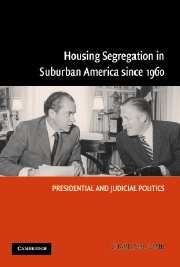Book contents
- Frontmatter
- Contents
- Preface and Acknowledgments
- Abbreviations
- Housing Segregation in Suburban America since 1960
- 1 Separate Worlds, Separate Lives
- 2 Lyndon Johnson and the Fair Housing Act
- 3 George Romney's Blueprint for Suburban Integration
- 4 Richard Nixon, Centralization, and the Policymaking Process
- 5 Suburban Segregation from Gerald Ford to Bill Clinton
- 6 The Federal Courts and Suburban Segregation
- 7 Conclusions
- Appendix
- Bibliography
- Index
6 - The Federal Courts and Suburban Segregation
Published online by Cambridge University Press: 21 November 2009
- Frontmatter
- Contents
- Preface and Acknowledgments
- Abbreviations
- Housing Segregation in Suburban America since 1960
- 1 Separate Worlds, Separate Lives
- 2 Lyndon Johnson and the Fair Housing Act
- 3 George Romney's Blueprint for Suburban Integration
- 4 Richard Nixon, Centralization, and the Policymaking Process
- 5 Suburban Segregation from Gerald Ford to Bill Clinton
- 6 The Federal Courts and Suburban Segregation
- 7 Conclusions
- Appendix
- Bibliography
- Index
Summary
Richard Nixon made an aggressive attempt to influence the United States Supreme Court during the 1968 presidential election and his first term as president. He vigorously criticized the criminal procedure decisions of the Warren Court in his 1968 campaign and vowed to name “strict constructionists” to the Court. President Nixon then had the remarkable opportunity of appointing four justices to the Supreme Court during his first three years in the White House. As central components of his Southern Strategy, Nixon selected Chief JusticeWarren E. Burger in 1969 and Associate Justices Harry A. Blackmun in 1970, Lewis F. Powell in 1971, and William H. Rehnquist in 1971. All were conservatives, as were Clement Haynesworth and G. Harrold Carswell, the two Nixon nominees rejected by the Senate. “These events placed the selection process of Supreme Court justices – and Supreme Court policymaking – on the front burner of American politics,” Sheldon Goldman observes. Rehnquist was later promoted to chief justice by President Reagan, perpetuating the “Nixon Court.” Nixon appointees therefore held the pivotal center seat on the Supreme Court for over three decades, sustaining Nixon's legacy long after he left office.
During the 1970s and 1980s, President Nixon's four Supreme Court appointees voted overwhelmingly as a unified bloc in criminal procedure and civil rights cases, precisely the areas of constitutional law emphasized by Nixon's Southern Strategy. This highly cohesive voting pattern enhanced the likelihood of Nixon's influence on the Court.
- Type
- Chapter
- Information
- Housing Segregation in Suburban America since 1960Presidential and Judicial Politics, pp. 204 - 253Publisher: Cambridge University PressPrint publication year: 2005



